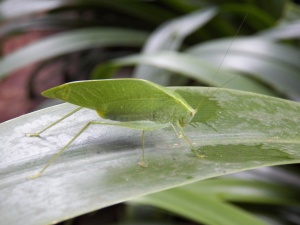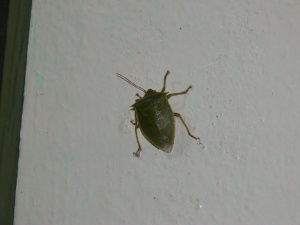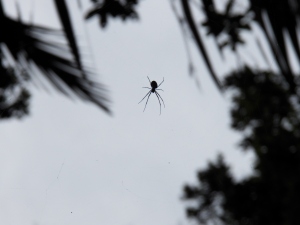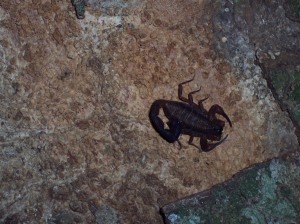Fauna of Puerto Rico: Part 2
I’m going to devote this post to some of the arthropods I’ve seen here, so if anyone is a bit bothered by insects or arachnids, you might not want to go through all the pictures I have here.
Tettigoniidae, Katydids
Katydids are relatives of grasshoppers and crickets, all within the order Orthoptera. They are distinguished by their very long antennae. Often, they are green to blend in with the vegetation they eat, but the ones around here take it up a notch. They are downright cryptic, mimicking green leaves right down to the venation. I have really enjoyed how common these are around here, often ending up in our kitchen (they seem to be attracted to light). The ones I’ve seen have been up to about 3 inches long. They are simple enough to pick up if you grab them by the back of the wing or the hind legs so they can’t jump away. I’ve looked at them with a magnifying glass (which they nonchalantly crawled over as I was holding it) and saw that they have very hard mandibles, as evidenced by the dark, nearly black, color of the keratin. They are able to fly, but it isn’t what I would call graceful or smooth (more of a slow, fluttering mass of wings).
Pentatomidae, Stink Bugs
Stink bugs (or at least this looked like one to me) are insects within the order Hemiptera, based on their piercing-sucking mouthparts. This family is characterized by having 5-segmented antennae and shield-shaped bodies. Many species produce a sort of odor to protect them from predators while they stick their straw-like mouth into a plant stem to suck out sugary water. I haven’t seen too many of these here, but this one landed on me in the kitchen and it was big enough that I could get a shot of it (about 1.5 inches).
Araneae, Spiders
Alright, I don’t know a lot about spider diversity. There are many spider families, and having never taken a class on spider biology, I missed out on learning most of them. This is the kind of spider that we see everywhere in the forest, often building webs at face level across all of the paths. I couldn’t really get a good picture of one with it’s color showing well, so I figured the back-lit one looked cool enough for my blog. In reality, these spiders come in a bunch of colors, but all have distinct orange spots on their undersides. The top side usually has lines extending the length of the body in green, black, or red. They aren’t very big (maybe 1.5 inches including legs), but they are abundant. I suppose they must feed well on all of the insects in the forest (all spiders are carnivorous, usually insectivorous), though as my coworker pointed out to me the other day, you never see one with any prey in its web. Their passive feeding strategy of sitting and waiting for some unfortunate small insect to fly into their web seems to work pretty well considering the number of webs strung around the woods. However, their passive strategy becomes a lot more active when there are a bunch of tree census volunteers crashing through their webs every day.
Scorpiones, Scorpions
We finally got to see a scorpion today! We had eaten lunch at the top of a ridge under a couple of big trees (DACEXC, but more on that in a later post) with peeling bark. As we got up to start working again, my coworker brushed against the side of the trunk and a piece of bark sloughed off. Under it, there was a sort of cockroach (one of these days I’ll get a picture to represent that order, but they’re fast) that bolted away under the bark. We pried off a few more pieces of bark and found this wonderful arachnid quietly sitting there underneath the bark. It seemed not to be bothered by our presence and made no effort to harm us (though we stood a good distance back).
This scorpion, since it was found under the bark of a tree, is probably in the family Buthidae, the bark scorpions. All scorpions are carnivores, mainly insectivores, like their fellow arachnid spiders. They catch prey with their claws and immobilize it with their stinger (which they also use for defense from potential predators). We’ve been told that these guys aren’t too dangerous, but it is still better to avoid them if possible.
There are so many neat arthropods here (I’ve really got a soft spot for insects especially) so I’ll hope to get more pictures and put them in a later Fauna of Puerto Rico post.




Wonderful posts Mark! But please, can you post more bird stuff? Thanks!